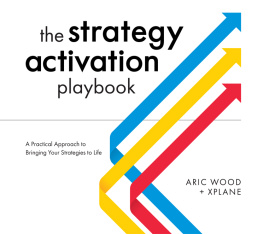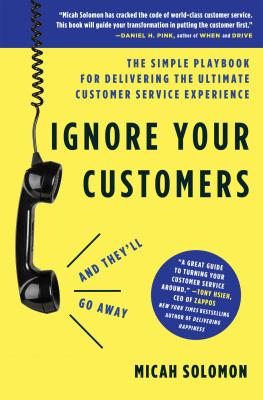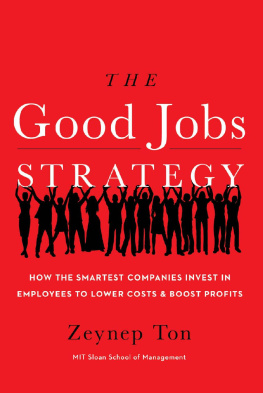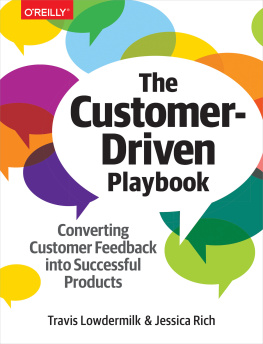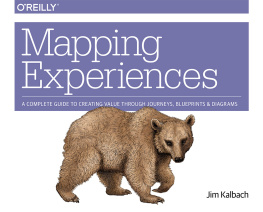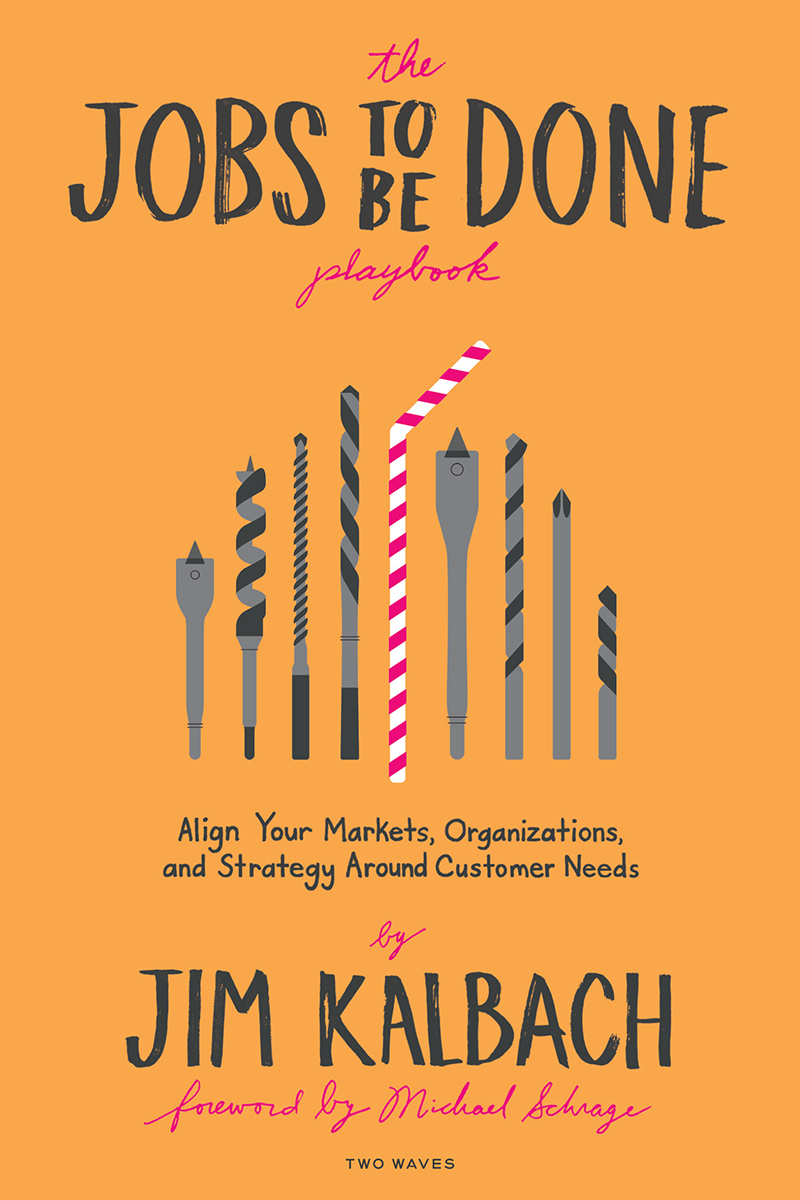Contents
the
JOBS TO BE DONE
playbook
Align Your Markets, Organization, and Strategy Around Customer Needs
by
JIM KALBACH
Foreword by Michael Schrage
The Jobs to Be Done Playbook
Align Your Markets, Organizations, and Strategy Around Customer Needs
By Jim Kalbach
Two Waves Books
an imprint of Rosenfeld Media
125 Maiden Lane, Suite 209
New York, New York
10038 USA
On the Web: twowavesbooks.com
Please send errors to:
Publisher: Louis Rosenfeld
Managing Editor: Marta Justak
Illustrations: Michael Tanamachi
Interior Layout Tech: Danielle Foster
Cover and Interior Design: The Heads of State
Indexer: Marilyn Augst
Proofreader: Sue Boshers
2020 Jim Kalbach
All Rights Reserved
ISBN: 1-933820-68-3
ISBN 13: 978-1-933820-68-2
LCCN: 2019948483
Printed and bound in the United States of America
For my brother
Contents and Executive Summary
At a time when consumers have unprecedented choices, JTBD offers a way of seeing markets to maximize growth around customer needs. The core message of JTBD is clear: focus on peoples objectives, not on your company, offering, or brand.
JTBD is a broad field with a decades-old history and varying perspectives unified by a set of shared principles. Begin your JTBD by understanding the core tenets of the theory and practice.
A common language of JTBD helps filter otherwise irregular market feedback into a normalized system. Apply the JTBD framework to better predict your customer-driven growth.
People value products and services that help them get a job done. Find your opportunities by interviewing people in your market and mapping their job.
JTBD provides a way to model various aspects of your market. Identify unmet needs and define your target markets all through the JTBD lens.
JTBD is versatile and provides many techniques for developing solutions. After understanding the problem you are solving, use JTBD to design products and services that customers really want.
Offering solutions that get a core job done can create a strong market pull, but thats often not enough. Use JTBD to accelerate your go-to-market efforts as well.
JTBD not only frames innovation and marketing efforts, but it also provides a way of grounding strategy in real-world observations. Use various techniques to guide your business at the highest levels.
The practice of JTBD includes various methods and techniques. Find the best combination of plays to fit your situation and address your specific challenges.
Foreword
Some books are written primarily to be read; others are written mainly to be used. Jim Kalbachs book, The Jobs to Be Done Playbook, should inspire the best of both. The reason is not just that Jim is a fluent writer with a crisp and clear purpose, but that he treats the fundamentals of user design, user experience, and the job to be done with thoughtfulness, seriousness, and rigor. I cannot overstate how important that is.
In my classes, workshops, and advisory work, I have the good fortune to work with talented people who truly want to do excellent work. I like and admire them. They are talented and smart. But oftentimes, because they are so talented and smart, they presume or assume they know the fundamentals of something when, in truth, they do not. With apologies to Atul Gawande, they have a Checklist Manifesto grasp of what theyre trying to do. That is, theyre doing everything theyre supposed to do but lack an essence and esprit that makes the work compelling. What people minimize (or overlook) about Gawandes checklists is that they are supposed to be prompts and reminders for people who truly know their stuff. The challenge here is that peoplesmart people, caring peopledont always quite know the right stuff.
Yes, they know the product and the service and the desired and desirable user experience, but do they really understand and appreciate the power and importance of the job to be done? The concept is simple and straightforwardits scalable, implementable, and extensible. Instantiation is not.
Thats why Jims book is so useful and important. Hes got the rigor and the chops to not only make the fundamentals accessible and understandable, but practical and doable as well. While I am a huge Clay Christensen fan (indeed, he was kind enough to write a blurb for one of my books), I think hed be one of the first to acknowledge that his breakthrough conceptual thinking requires facilitators, translators, and interlocutors to make it work in the real world. With tongue firmly in cheek, its quite a job to be done to get the job to be done done. But thats what Jims book empowers you to do.
This is not a book to be read in a sitting or a transcontinental flight. Similarly, youre a jerk if you hand it to a colleague or a boss without spending some time with it yourself. The real way to get value from this book is to ask yourselfhonestly and openlywhere your greatest frustration lies as a value creator. Then start leafing through this booknot to find yourself or the answer, but to understand the essential fundamentals of the job to be done.
Michael Schrage
Research Fellow at MITs Initiative on the Digital Economy and
author of Who Do You Want Your Customers to Become? (HBR Press)
Introduction
In April 2013, I gave a workshop at UX London, a premier design conference that attracts participants from around the world. As a speaker, I also got to attend the conference. The lineup of presenters was stellar, as it typically is, and I didnt want to miss out on the world-class content presented there. So prior to the event, I scoured the program to see which sessions would be most interesting.
One workshop in particular caught my eye: Des Traynors Where UX Meets Business Strategy. This was a three-hour session focused on how design influences business and vice versa. More specifically, Des was going to look into How to orient a company around a job-to-be-done, as he wrote in the session description.
It couldnt have been a better mix of topics to match my interests at the timethe intersection of design, strategy, and jobs to be done (JTBD). I remember distinctly how intent I was on making it to that session. I had been learning all I could about JTBD and trying some techniques in my work. This was right up my alley. Like Des, I believe that business success comes from understanding human needs and motivations.
I flew to UX London from Hamburg, Germany, where I was living at the time, the day before the event. The organizers had arranged for a car to pick me up from the airport. After I found the driver, he informed me that wed have to wait a few minutes for another passenger. He pulled out a piece of paper with the persons name on it before standing at the end of the arrivals area. It read Des Traynor, UX London. I broke into a huge grin.
On the drive from Heathrow to the conference hotel, Des and I talked a lot about jobs to be done. He has a design background and was able to relate to my perspective of the field quite well. We were seeing eye to eye. In fact, during his workshop, Des asked me to speak to the audience of about 80 people for a few minutes, based on my experience with JTBD research.


